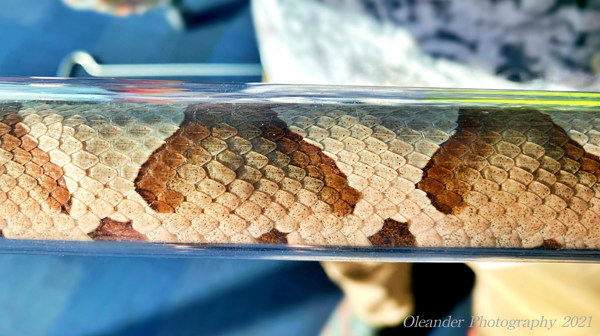
Explore This Issue
ACEP Now: Vol 40 – No 09 – September 2021Answer: Very! Get yourself to an emergency department immediately!
Southern copperheads (Agkistrodon contortrix) are venomous snakes of the pit viper family that live in the southeastern United States.
Where I currently work, it is not unusual for someone to show up with a piece of the snake that bit them—a head, tail, or other pieces. Although the copperhead is the most common viper bite in my area of the country, sometimes copperheads can be confused with other nonvenomous snakes.
Knowing this snake’s attributes can markedly change the conversation and expectations when your very anxious patient shows up in your emergency department with bleeding teeth marks on their skin from an encounter with a snake.
Anatomy
Knowing the copperhead snake anatomy will help you distinguish it from other snakes.
Head
Eyes: It has black vertical slit pupils.
Nose: It has a “pit” on either side of the snout that is used for heat location and identifying prey. These are found proximal and lateral to the nostril.
Mouth: Front hinged fangs are used to bite and inject venom into prey animals and for defense.
Cheeks: Large, bulbus cheeks on either side of the head house venom glands. This makes the “triangle” head that vipers are known for.
Neck
The snake has a narrow neck that is thinner than the head and the rest of the body.
Body
The length is usually two to three feet but can be longer.
Coloration
The head is often the striking color of a freshly minted penny. The body is noted for a tan and dark pattern shaped like an hourglass when viewed from above or like triangles or chocolate kisses when viewed from the side (see photo). This camouflage is very effective at mimicking leaf litter on the forest floor.
Juvenile colors are notable for a yellow tail tip that they eventually outgrow. This coloration may act as a distraction if the snake is detected (the predator would go for the tail and not the head), or it might be used to attract prey.
Life Cycle and Habits
Copperheads are viviparous—they are born free from eggs from their mothers. They have the ability to move around and bite from day one. They are diurnal, awake and hunting or basking during the day. They are primarily found in wooded areas near water. They eat many small mammals (mice, chipmunks, squirrels, etc.) when able or some of the larger insects (cicadas, caterpillars, etc.).
Treatment Decisions
Figuring out which snake put holes in your patient is the key to deciding whether they need local wound care and follow-up or if you need to call the pharmacy to see how much antivenin is available!
The North Carolina Museum of Natural Sciences has a handout, “A Guide to Identifying the Copperhead,” with more beautiful pictures of this animal (https://files.nc.gov/ncparks/copperhead-field-id-guide.pdf).
Big thanks to Dr. Sean Bush for providing the snake for my pictures
Pages: 1 2 | Multi-Page






One Response to “Tox Q&A Answer: Venom Dilemma”
October 1, 2021
Patrick SnowmanHey Jason. Patrick Snowman, MD, FAAEM from Hilton Head. I treat at least 15 copperhead bites a year times 18 year….i.e. a lot since moving down here from New England where there are essentially no poisonous snakes. The treatment seems to have morphed from automatic admission and 4 to 6 viles up front and 6 more vials every 6 hours over 18 hours to much less than that and discharge from ED if very well controlled, of course with the appropriate lab work etc .
I find the SC poison control center (for whom I have huge accolades!!) tend to be Uber conservative with copperhead tx and wondering what your actual practice guidance/pattern is.
I’m really talking lower, lower extremity injuries not hands or other edge cases. I do find that keeping patients advocate non weight bearing for at least 48 to 72 hours is very important as well as elevation etc, but feel that most patients after 4 to 6 viles of CroFab are good to go. What are your thoughts.